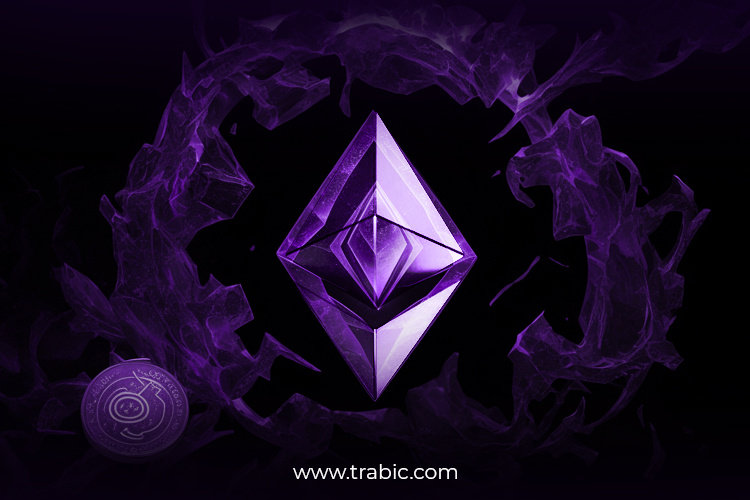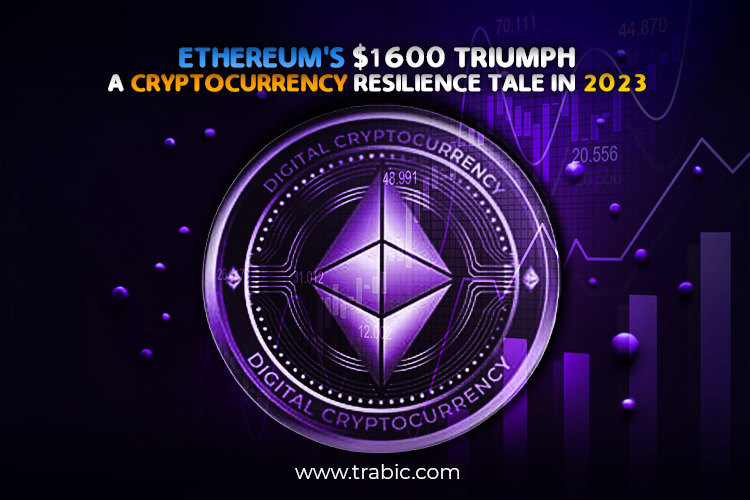Cryptocurrencies have taken the financial world by storm, and Ethereum has been at the forefront of this digital revolution. Since its inception, Ethereum has faced numerous challenges, including scalability issues, regulatory hurdles, and market volatility. However, the cryptocurrency’s journey to reach and maintain a price point of $1600 serves as a testament to its resilience and enduring value. This blog post will explore Ethereum’s Battle for $1600 and what it signifies for the broader cryptocurrency ecosystem.
In the tumultuous world of cryptocurrencies, Ethereum’s recent struggle to maintain a price level of $1600 serves as a testament to the resilience of this groundbreaking blockchain platform. Ethereum, the runner-up in the cryptocurrency realm concerning market capitalization, has grappled with many trials, ranging from the intricacies of scalability to the predicament of network congestion. However, the ability of Ethereum to weather these storms and remain a cornerstone of the blockchain industry underscores its fundamental strength.
One critical insight from Ethereum’s Battle for the $1600 mark is the enduring popularity of decentralized applications (DApps) and the broader Ethereum ecosystem. Despite competition from newer blockchain platforms, Ethereum remains the preferred choice for developers and entrepreneurs looking to build innovative DApps and smart contracts. This demand has contributed to Ethereum’s staying power and ability to maintain a substantial market share.
Another important factor contributing to Ethereum’s resilience is its ongoing commitment to addressing scalability issues. Ethereum 2.0, an ambitious endeavor poised to shift from its current proof-of-work underpinning to a revolutionary proof-of-stake consensus mechanism, is underway in its developmental phases. This upgrade promises to significantly improve transaction throughput and reduce network congestion, making Ethereum more scalable and sustainable in the long term.
Ethereum’s Battle for $1600 also highlights the broader market dynamics of the cryptocurrency space. Cryptocurrencies have earned an infamous reputation for their propensity for price turbulence, and Ethereum stands as a quintessential embodiment of this inherent trait. It’s subject to many factors, including market sentiment, regulatory developments, and macroeconomic trends. The ability of Ethereum to rebound from price fluctuations demonstrates its ability to adapt to changing market conditions.
Moreover, Ethereum’s role in facilitating decentralized finance (DeFi) cannot be understated. The DeFi ecosystem relies heavily on Ethereum’s infrastructure, including smart contracts and the Ethereum Virtual Machine (EVM). The continued growth of DeFi projects and the substantial value locked in these protocols further solidify Ethereum’s position in the cryptocurrency landscape.
Ethereum’s Battle for $1600 underscores its resilience and enduring significance in cryptocurrency. Its ability to navigate challenges, adapt to evolving technology, and maintain its status as a platform of choice for developers and entrepreneurs speaks to the enduring strength of this blockchain. As the cryptocurrency space continues to evolve, Ethereum will likely remain a central player, driving innovation and progress within the industry.
The Genesis of Ethereum

Ethereum, created by Vitalik Buterin and launched in 2015, introduced the concept of smart contracts and decentralized applications (DApps). Its innovative blockchain technology enabled developers to build decentralized platforms, laying the foundation for the decentralized finance (DeFi) and non-fungible token (NFT) ecosystems we see today. Ethereum quickly gained popularity, and its native cryptocurrency, Ether (ETH), became one of the leading digital assets in the market.
The Path to $1600
Ethereum’s price has been characterized by extreme volatility since its inception. It experienced rapid price increases, reaching an all-time high of around $1,600 in early 2018 before the infamous crypto market crash. In the years that followed, Ethereum’s price fluctuated, mirroring the broader cryptocurrency market’s movements.
Several factors contributed to Ethereum’s struggle to regain and surpass the $1600 mark:
- 1. Scalability Challenges: Ethereum grappled with intricate scalability challenges, giving rise to network congestion and exorbitant transaction fees. Users were deterred by the rising cost of interacting with smart contracts and DApps, impacting Ethereum’s adoption.
- Competition: Ethereum faced competition from newer blockchain platforms that aimed to address its scalability issues, such as Binance Smart Chain, Polkadot, and Solana. These platforms offered faster and cheaper transactions, diverting some user and developer attention from Ethereum.
- Regulatory Uncertainty: Cryptocurrency markets are susceptible to regulatory developments—the uncertainty surrounding the classification and regulation of cryptocurrencies created uncertainty in the Ethereum ecosystem.
- Technological Upgrades: Ethereum underwent significant upgrades, including Ethereum 2.0, transitioning from a proof-of-work (PoW) to a proof-of-stake (PoS) consensus mechanism. While these upgrades promised improved scalability and reduced energy consumption, they also introduced complexity and uncertainty.
The Resilience of Ethereum
Despite these challenges, Ethereum persevered and demonstrated remarkable resilience:
- 1. Developer Ecosystem: Ethereum boasts a vibrant and active developer community that continually improves the network’s infrastructure and develops innovative DApps. This commitment to improvement helps Ethereum maintain its relevance.
- DeFi and NFT Boom: Ethereum remains the dominant platform for DeFi and NFT projects. The explosion of DeFi and NFTs has driven significant demand for ETH, reinforcing its value proposition.
- Ethereum 2.0 Progress: While complex, the transition to Ethereum 2.0 addresses scalability concerns and enhances the network’s sustainability. Progress on this front has boosted confidence in Ethereum’s long-term potential.
- Institutional Adoption: Institutional interest in Ethereum has grown, with major companies and investment firms exploring ETH as a store of value and investment assets. This institutional backing provides stability to the ecosystem.
Let’s delve deeper into some key insights regarding Ethereum’s Battle for $1600 and its broader implications:
- Ecosystem Maturity: Ethereum’s journey to $1600 reflects the maturity of its ecosystem. While younger blockchain projects may experience wild price swings and struggle to gain traction, Ethereum’s resilience is a testament to its foundations’ solidity and widespread adoption.
- The DeFi and NFT Connection: Ethereum’s pivotal role in the DeFi and NFT sectors cannot be overstated. DeFi platforms rely heavily on Ethereum’s innovative contract capabilities, while NFTs are predominantly minted on the Ethereum blockchain. These use cases have provided consistent demand for ETH, creating a solid foundation for its price.
- Decentralization vs. Scalability: Ethereum’s transition to Ethereum 2.0, aimed at improving scalability and sustainability, demonstrates the balance between decentralization and scalability that blockchain platforms must achieve. While Ethereum seeks to maintain decentralization through PoS, other blockchains prioritize high throughput at the expense of decentralization.
- Institutional Involvement: The growing interest of institutional investors in Ethereum showcases its broader acceptance as a legitimate asset class. This institutional support contributes to Ethereum’s price stability and signals a maturing market.
- The Regulatory Landscape: The regulatory environment for cryptocurrencies remains a moving target, and Ethereum is not immune to these regulatory changes. As governments and regulatory bodies define their approach to cryptocurrencies, Ethereum’s adaptability will be crucial in navigating the evolving landscape.
- Ethereum’s Role in Web3: Ethereum’s Battle for $1600 is not just about price; it’s about its place in the more significant Web3 movement. Ethereum is at the forefront of enabling decentralized applications, decentralized finance, and a new internet architecture. Its success is intertwined with the success of a more decentralized and user-centric web.
- Global Economic Factors: The price of Ethereum, like other cryptocurrencies, is influenced by global economic factors. Economic crises, inflation concerns, and currency devaluation in various countries have driven interest in cryptocurrencies as alternative stores of value, bolstering Ethereum’s price.
- Community Engagement: Ethereum’s strong and engaged community of developers and enthusiasts has played a pivotal role in its resilience. The collective drive to overcome technical challenges and find innovative solutions has driven Ethereum’s progress.
- Interoperability and Layer 2 Solutions: Ethereum’s journey to $1600 has highlighted the importance of interoperability and layer 2 solutions. These technologies can help alleviate congestion on the leading Ethereum network, reduce fees, and enhance scalability, making Ethereum more accessible and efficient.
- Environmental Concerns: Ethereum’s transition to PoS is timely as the world becomes more environmentally conscious. It addresses concerns about the energy consumption associated with PoW blockchains and aligns with the global push for sustainable technologies.
Ethereum’s Battle for $1600 is a multifaceted story of innovation, resilience, and adaptability. Its journey reflects the broader evolution of the cryptocurrency market and its growing integration into mainstream finance and technology. As Ethereum continues to overcome challenges and reach new milestones, it solidifies its place as a transformative force in the digital age. However, investors and enthusiasts must remain vigilant and informed as the cryptocurrency landscape evolves.
Ethereum Nebula: Future Possibilities and Pitfalls

Predicting the future of Ethereum, or any cryptocurrency, is a complex and highly speculative endeavor. Many factors influence the cryptocurrency market, including technological developments, regulatory changes, market sentiment, and economic conditions. While it’s impossible to provide a definitive prediction, we can outline some potential scenarios and trends that may shape Ethereum’s future:
- Ethereum 2.0 and Scalability: Ethereum’s transition to Ethereum 2.0, moving from proof-of-work (PoW) to proof-of-stake (PoS), aims to improve scalability, energy efficiency, and security. This upgrade could position Ethereum as a more efficient and sustainable blockchain platform capable of handling a broader range of applications.
- DeFi and NFT Growth: Ethereum’s dominance in the DeFi and NFT sectors will likely continue. As these sectors expand and mature, Ethereum could see increased demand for its native cryptocurrency, Ether (ETH), further supporting its price.
- Competition and Interoperability: Ethereum faces competition from other blockchain platforms seeking to address its scalability issues. Interoperability and layer two scaling solutions may help Ethereum maintain relevance by reducing congestion and transaction fees.
- Regulatory Developments: The regulatory landscape for cryptocurrencies is evolving. How governments and regulatory bodies treat Ethereum will significantly impact its future. Clarity and favorable regulations encourage institutional investment, while adverse regulations create challenges.
- Institutional Adoption: Ethereum’s acceptance as an institutional asset could continue to grow. More institutions allocating funds to ETH could contribute to price stability and liquidity.
- Economic and Geopolitical Factors: Economic crises, currency devaluation, and geopolitical instability can drive interest in cryptocurrencies as a store of value. Ethereum, like Bitcoin, may benefit from such scenarios.
- Technological Advancements: Ethereum technology developments, including improvements in the Ethereum Virtual Machine (EVM), layer two solutions, and innovative contract capabilities, can attract developers and expand use cases.
- Environmental Concerns: Ethereum’s transition to PoS aligns with growing environmental consciousness. As environmental concerns intensify, PoS-based Ethereum may become more appealing to those concerned about the carbon footprint of PoW cryptocurrencies.
- Adoption in Developing Countries: Ethereum’s inherent decentralization and its inherent accessibility render it an enticing proposition for both individuals and enterprises situated in emerging economies, where conventional financial services remain elusive or restricted.
- Market Sentiment and Speculation: Cryptocurrency markets are highly influenced by market sentiment and speculation. Rapid price movements, both upward and downward, are possible due to the speculative nature of the market.
It’s important to emphasize that cryptocurrency investments carry inherent risks, and the market can be highly volatile. Individuals contemplating investment in Ethereum are encouraged to engage in meticulous due diligence, meticulously assess their risk appetite, and, where deemed prudent, seek counsel from financial experts. While Ethereum has shown resilience and innovation, the cryptocurrency market is still relatively young, and its long-term future remains uncertain. As with any investment, exercising caution and diversifying your portfolio is essential.
The Ethereum’s Battle Effect: Pioneering Change Across Multiple Sectors

Ethereum has had a significant impact on the cryptocurrency market and beyond. Its influence extends to various aspects, including technological innovation, financial markets, and the broader blockchain ecosystem. Here are some critical effects of Ethereum on the market:
- Pioneering Smart Contracts: Ethereum introduced the concept of smart contracts, self-executing agreements with the contract terms directly written into code. This groundbreaking innovation has exerted a profound and far-reaching influence across diverse sectors, encompassing finance, jurisprudence, supply chain management, and beyond. Its capacity to automate intricate procedures and curtail reliance on intermediaries has been transformative.
- Decentralized Applications (DApps): Ethereum’s blockchain serves as an innovative canvass, empowering developers to craft decentralized applications (DApps) that epitomize the pinnacle of blockchain-driven innovation. These applications operate without centralized control, offering transparency, security, and censorship resistance. Ethereum has given rise to a thriving ecosystem of DApps, including decentralized finance (DeFi) platforms, non-fungible token (NFT) marketplaces, and more.
- Ethereum’s Role in DeFi: Ethereum is the primary blockchain for DeFi applications, which include lending, borrowing, decentralized exchanges, and yield farming platforms. The growth of DeFi has been a significant driver of demand for Ethereum and has introduced new financial instruments and possibilities.
- NFT Craze: Ethereum’s support for NFTs has fueled the non-fungible token boom. Artists, musicians, and creators use Ethereum’s blockchain to tokenize their digital assets, leading to the sale of unique digital collectibles and artworks.
- Market Capitalization and Dominance: Ethereum consistently holds a significant share of the total cryptocurrency market capitalization. Its performance has a noticeable impact on the overall market sentiment and trends.
Liquidity: Ethereum is one of the most liquid cryptocurrencies, with high trading volumes on various popular exchanges. Its liquidity makes it a famous trading pair with other cryptocurrencies. ETH trading pairs’ availability contributes to the crypto market’s liquidity and trading activity.
Conclusion
In this comprehensive discussion, we’ve explored the multifaceted and ever-evolving landscape of Ethereum, one of the most prominent cryptocurrencies in the world. Ethereum’s journey has been marked by resilience, innovation, and its influential role within the broader cryptocurrency market. Here’s a detailed summary of our discussion:
- Ethereum’s Genesis: Ethereum was created by Vitalik Buterin in 2015 as a groundbreaking blockchain platform that introduced intelligent contracts and decentralized applications (DApps). It quickly gained popularity and became a cornerstone of the crypto ecosystem.
- The Battle for $1600: Ethereum has faced numerous challenges in reaching and maintaining a price point of $1600. These challenges include scalability issues, competition from other blockchain platforms, regulatory uncertainty, technological upgrades, and environmental concerns.
- Resilience and Adaptability: Ethereum has demonstrated remarkable resilience and adaptability despite these challenges. Its developer community remains active and continues to dominate in the DeFi and NFT sectors, driving demand for its native cryptocurrency, Ether (ETH).
- Ethereum 2.0: The transition to Ethereum 2.0, shifting from proof-of-work
(PoW) to proof-of-stake (PoS), represents a critical milestone. It addresses scalability concerns and environmental issues while enhancing Ethereum’s long-term sustainability.
- Institutional Interest: Ethereum has attracted institutional interest as a store of value and investment asset. Institutional backing provides stability and credibility to the ecosystem.
- Regulatory Impact: The evolving regulatory landscape can significantly influence Ethereum’s future. Clear and favorable regulations can encourage further adoption, while adverse regulations may create challenges.
- Technological Advancements: Ethereum’s ongoing technological improvements, including layer two solutions and innovative contract capabilities, enhance its utility and relevance.
- Global Economic Factors: Ethereum’s performance is affected by global economic conditions, including economic crises, inflation concerns, and currency devaluation, which drive interest in cryptocurrencies as alternative assets.
- Environmental Considerations: Ethereum’s transition to PoS aligns with growing environmental awareness and concerns about the energy consumption of PoW blockchains.
- Influence on the Market: Ethereum’s impact on the broader cryptocurrency market is substantial. It contributes to market capitalization and liquidity and is a benchmark for other cryptocurrencies. Ethereum’s technological innovations have inspired the development of other blockchain projects.
- Ethereum’s Role in DeFi and NFTs: Ethereum’s pivotal role in the DeFi and NFT sectors has driven significant demand and adoption. Its blockchain serves as the foundational bedrock for numerous DeFi protocols, standing as the paramount conduit for the genesis and exchange of non-fungible tokens (NFTs).
In conclusion, Ethereum’s journey and ongoing evolution exemplify the resilience and adaptability of cryptocurrencies in a rapidly changing financial landscape. While predicting the future of Ethereum is challenging, its continued development, institutional support, and role in transformative sectors like DeFi and NFTs suggest that it will remain a vital player in the world of blockchain technology and finance. However, as with any investment, caution, thorough research, and diversification are essential when considering participation in the cryptocurrency market.
